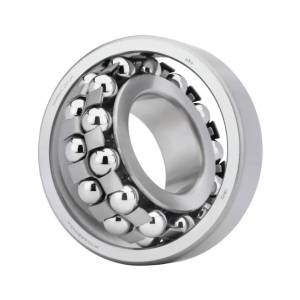Description
Self-Aligning Ball Bearings: Superior Performance and Durability
Self-aligning ball bearings, also known as spherical ball bearings, are a type of rolling element bearing designed to accommodate significant misalignment between the shaft and housing. Unlike standard deep groove ball bearings, these bearings excel in applications where shaft deflection, housing misalignment, or both are unavoidable. This makes them ideal for a wide range of industrial and automotive applications demanding high load capacity and extended operational life.
Key Features & Benefits:
- Self-Aligning Capability: The distinctive spherical outer ring allows for angular misalignment between the shaft and housing, compensating for imperfections and preventing premature bearing failure due to misalignment. This feature significantly enhances bearing life and reduces vibration.
- High Load Capacity: Self-aligning ball bearings are designed to handle both radial and axial loads, making them versatile for a variety of applications. The precise manufacturing and robust design contribute to their ability to sustain heavy loads without compromising performance.
- Reduced Friction & Smooth Operation: The smooth rolling action of the balls within the raceways ensures low friction, resulting in quieter operation, improved efficiency, and reduced energy consumption.
- Easy Installation & Maintenance: Typically simpler to install than other bearing types due to the inherent tolerance for misalignment. Routine maintenance is also often easier, contributing to lower overall operational costs.
- Durable Construction: Crafted from high-quality materials such as chrome steel, these bearings are built to withstand harsh operating conditions, offering exceptional durability and longevity. Precision manufacturing ensures consistent performance and minimizes wear.
- Wide Range of Sizes and Configurations: Available in a variety of sizes and configurations to meet the specific requirements of diverse applications. Options include different materials, seals, and internal designs to optimize performance for particular operating conditions.
Applications:
Self-aligning ball bearings find extensive use in numerous applications, including:
- Agricultural Machinery: Combines, tractors, and other heavy-duty agricultural equipment.
- Automotive Industry: Suspension systems, transmissions, and other components subject to misalignment.
- Material Handling Equipment: Conveyors, lifts, and other machinery handling heavy loads.
- Textile Machinery: Spinning machines, weaving looms, and other equipment operating under variable loads.
- General Industrial Machinery: Pumps, motors, and other rotating equipment susceptible to misalignment.
Specifications (General):
While specific specifications vary greatly depending on size and manufacturer, common parameters include:
- Bore Diameter: The inner diameter of the bearing, determining the shaft size it accommodates.
- Outer Diameter: The outer diameter of the bearing, dictating the housing size.
- Width: The width of the bearing, affecting its load capacity and rigidity.
- Static Load Rating: The maximum static load the bearing can withstand without permanent deformation.
- Dynamic Load Rating: The maximum dynamic load the bearing can handle for a specified number of revolutions.
- Operating Temperature Range: The temperature range within which the bearing can operate effectively.
Choosing the Right Self-Aligning Ball Bearing:
Selecting the appropriate self-aligning ball bearing requires careful consideration of several factors, including:
- Load Requirements: Radial, axial, and combined loads.
- Shaft and Housing Dimensions: Ensure compatibility with existing equipment.
- Operating Speed: RPM of the rotating shaft.
- Operating Environment: Temperature, humidity, and potential contaminants.
For assistance in selecting the ideal self-aligning ball bearing for your specific application, please consult our technical documentation or contact our sales team.
